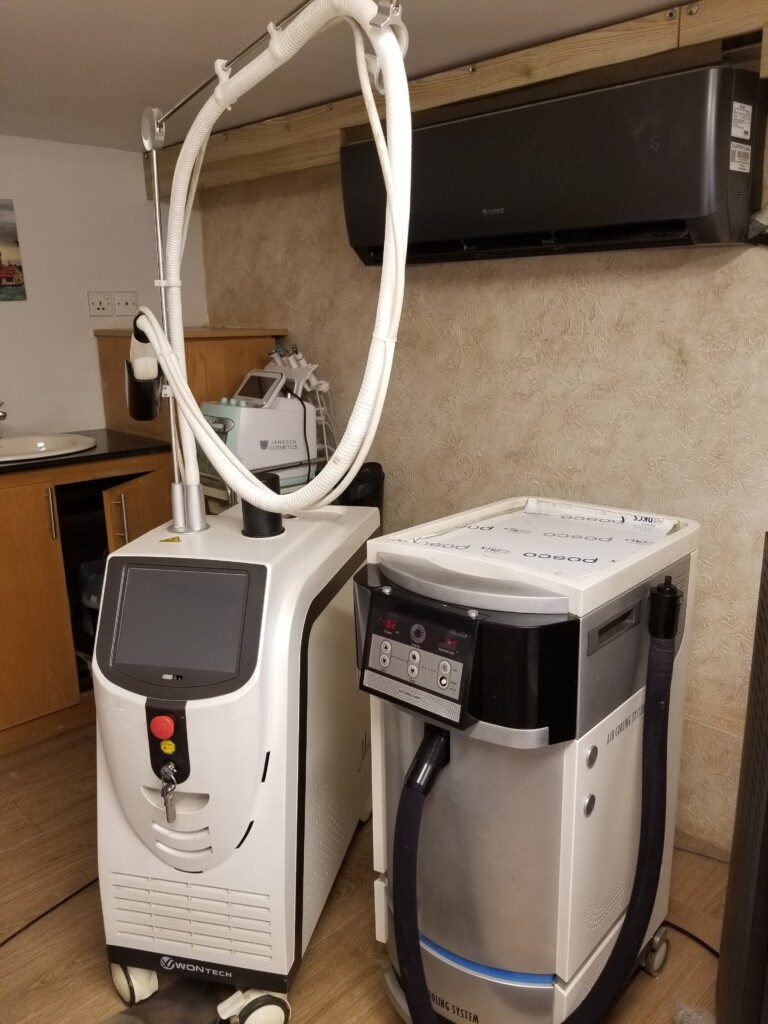Last updated on October 21st, 2025 at 12:08 pm
I recently had a laser hair removal session on my bikini area by Dr. Seema Hirji and it was done using the ADX machine along with a chiller to cool down my skin during the process. The cooling feature was great, as it helped reduce any discomfort, making the whole experience much easier.
The ADX is ideal for the bikini area because it uses advanced laser technology that allows for precise targeting, ensuring effective hair removal on sensitive skin. Its customizable settings and fast treatment time make it perfect for sensitive areas, providing smooth results with minimal irritation.

Laser hair removal on the bikini area can be an effective way to reduce unwanted hair and keep the skin smooth. However, like any cosmetic procedure, it comes with some potential side effects. Knowing what these side effects are can help you decide if laser hair removal is the right choice for you. Here’s a look at the most common side effects and how to manage them.
Jump to
Can bikini laser cause infertility
Side affects of bikini laser hair removal
1. Redness and Swelling
After a laser hair removal session, you may notice some redness and swelling. This reaction is common in sensitive areas like the bikini line. The laser targets hair follicles, which can cause minor irritation in the surrounding skin. Redness and swelling can show up within minutes of treatment and usually last for a few hours. In some cases, these effects may stick around for a day or two.
What You Can Do: Applying a cool, damp cloth to the area can help soothe your skin. Many people find that aloe vera gel or a gentle moisturizer can reduce redness and help with healing.
2. Temporary Skin Sensitivity
It’s common for the bikini area to feel more sensitive after laser hair removal. Some people experience mild stinging or tenderness. This happens because the laser heats the hair follicles, causing a slight inflammatory response in the skin. Skin sensitivity usually fades within a few hours to a day.
How to Soothe Sensitive Skin: Avoid hot showers, saunas, or any activities that cause sweating right after treatment. Instead, wear loose-fitting, breathable clothing to avoid friction. Keeping the area clean and cool can prevent further irritation.
3. Changes in Skin Color
Laser hair removal may cause changes in skin pigmentation, especially in people with darker skin tones. This can result in either darkening (hyperpigmentation) or lightening (hypopigmentation) of the skin in the treated area. These changes are usually temporary, but in rare cases, they may last longer.
Prevention Tips: Avoid sun exposure before and after treatment. Sunlight can make pigmentation changes more likely. Use sunscreen on the bikini line if it might be exposed to the sun, and talk to your technician about the best settings for your skin type.

4. Mild Itching and Dryness
Some people experience mild itching or dryness after laser hair removal in the bikini area. This side effect is often a reaction to the skin’s healing process as it recovers from the laser treatment.
How to Handle It: To reduce itching, use a gentle, fragrance-free moisturizer on the area. Avoid scratching, as this can cause further irritation. Applying a hydrating gel or lotion designed for sensitive skin can help reduce dryness.
5. Risk of Burns or Blisters
In rare cases, laser hair removal can cause burns or blisters. These effects are more likely if the laser is set to an incorrect intensity level or if the technician is inexperienced. The bikini area’s sensitive skin can be more prone to these reactions.
How to Prevent Burns: Make sure to choose a qualified, licensed provider with experience in treating sensitive areas. Communicate openly with your technician about any pain during treatment. If the sensation feels intense or painful, ask them to adjust the settings.
Also read our article on How to treat sunburn fast
6. Risk of Ingrown Hairs
Laser hair removal can sometimes lead to ingrown hairs, especially if you have curly or coarse hair. When hair grows back, it may curl under the skin, causing small bumps or pimples. Ingrown hairs can be uncomfortable and may lead to further irritation.
How to Manage Ingrown Hairs: Exfoliate gently around the bikini area between sessions to prevent hairs from getting trapped under the skin. Avoid shaving or waxing the area right after laser hair removal, as this can make ingrown hairs more likely.
7. Scarring (Rare)
In very rare cases, laser hair removal can cause scarring in the treated area. Scarring is typically the result of improper aftercare or an adverse reaction to the laser. Although it’s uncommon, it’s important to be aware of this potential side effect.
Prevention and Treatment: Follow all post-treatment instructions carefully. Avoid scratching or picking at the treated area, and keep the skin moisturized to support healing. If you notice any unusual marks or if the area doesn’t seem to be healing, consult your technician or a dermatologist for advice.
8. Temporary Hair Shedding
A few days to weeks after your laser treatment, you may notice small hairs shedding from the bikini area. This is part of the hair removal process and is usually a good sign that the treatment is working.
What to Expect: Hair shedding is normal and usually stops within a couple of weeks. Avoid pulling out or scrubbing the shedding hair, as this can cause irritation. Let the shedding process happen naturally.
Is Laser Hair Removal Safe for the Uterus and Fertility? Here’s What You Need to Know
Laser hair removal is a popular option for reducing unwanted body hair, especially in sensitive areas like the bikini line. However, many people wonder if laser treatments in the bikini area could affect their uterus or fertility. The good news is that laser hair removal is considered safe for these organs and has no known impact on reproductive health. Here’s why laser treatments are safe for the uterus and why they don’t interfere with fertility.
Review after one year of treatment
It’s been a year since I started getting bikini laser hair removal treatments every four to five months, and the results have been impressive overall. The hair on the drier areas has reduced by nearly 95 percent, leaving the skin smooth and clean with minimal regrowth.
However, the hair closer to the vaginal area remains more persistent — it has definitely thinned out and slowed in growth, but it’s clear that this region is more stubborn, much like certain facial areas that resist complete removal.
On the positive side, my underarm hair growth has dropped significantly, showing just how effective consistent laser sessions can be over time.
Just incase, if this treatment seems expensive to you .I would suggest you to purchase a reasonable laser device Philips lumea for light laser treatment at home. I have been using it before taking professional treatment and it helped me so much in controlling my hair growth all over the body.
Here is the best deal for my readers

Final Thoughts: Is Laser Hair Removal Safe for the Bikini Area?
Laser hair removal in the bikini area can offer long-lasting results, but it’s essential to be prepared for the potential side effects. Most reactions, like redness, sensitivity, and slight pigmentation changes, are mild and go away within a few days. By following aftercare instructions and choosing an experienced provider, you can reduce the chances of experiencing more serious side effects.
If you’re ever unsure about a reaction, don’t hesitate to consult your provider or a dermatologist. With the right care, laser hair removal can be a safe and effective choice for smoother skin in the bikini area.




